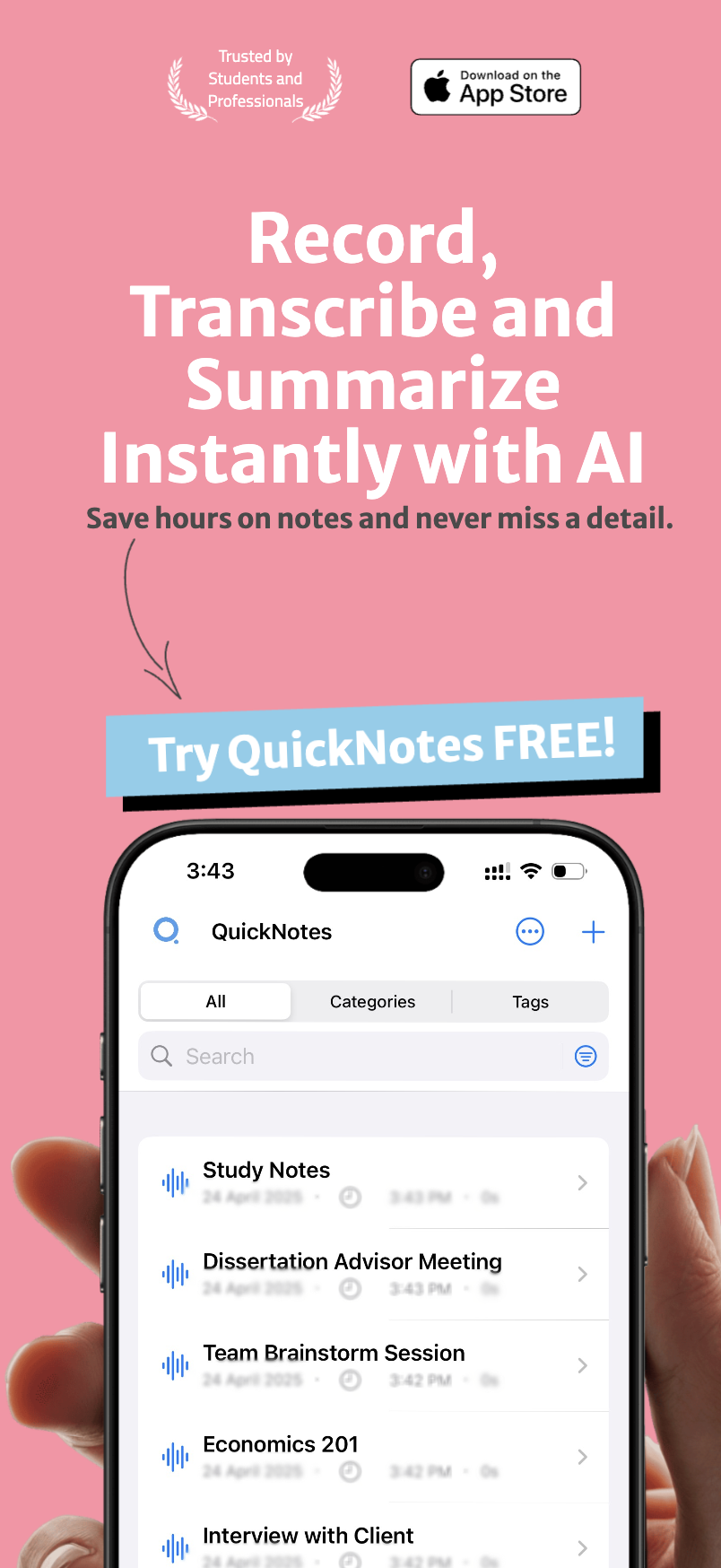Ever found yourself studying for hours on end, only to realize you've barely retained any information? Or perhaps you've experienced the frustration of sitting at your desk for what feels like an eternity, but accomplishing very little? If so, you're not alone—and the Pomodoro Technique might be the study hack you've been searching for.
Table of Contents
- What is the Pomodoro Technique?
- Why the Pomodoro Technique Works for Students
- 1. Combats Procrastination
- 2. Enhances Focus and Concentration
- 3. Prevents Burnout
- 4. Creates Awareness of Time
- Implementing the Pomodoro Technique with Digital Tools
- Customizing the Technique for Your Needs
- Advanced Pomodoro Strategies for Students
- Task Batching
- The 3-2-1 Method
- Digital Detox Pomodoros
- Common Challenges and Solutions
- Challenge: "I just get into flow and then the timer interrupts me."
- Challenge: "I still get distracted during pomodoros."
- Challenge: "I skip the breaks and keep working."
- Conclusion: Small Changes, Big Results
- You Might Also Like
What is the Pomodoro Technique?#
Developed by Francesco Cirillo in the late 1980s, the Pomodoro Technique is a time management method that breaks work into intervals, traditionally 25 minutes in length, separated by short breaks. These intervals are known as "pomodoros," named after the tomato-shaped kitchen timer Cirillo used as a university student (pomodoro is Italian for tomato).
The technique is beautifully simple yet remarkably effective:
- Choose a task you want to work on
- Set a timer for 25 minutes
- Work on the task until the timer rings
- Take a short break (5 minutes)
- After completing four pomodoros, take a longer break (15-30 minutes)
Why the Pomodoro Technique Works for Students#
1. Combats Procrastination#
One of the biggest challenges students face is simply getting started. The Pomodoro Technique helps overcome this hurdle by breaking study sessions into manageable chunks. Committing to just 25 minutes feels far less daunting than sitting down for a three-hour study marathon.
2. Enhances Focus and Concentration#
In our digital age of constant notifications and distractions, maintaining focus is increasingly difficult. The time-boxed nature of the Pomodoro Technique creates a sense of urgency that helps maintain concentration. Knowing you only have 25 minutes encourages you to make the most of that time.
Many students find they can resist checking social media or responding to non-urgent messages when they know they'll have a designated break coming up soon.
3. Prevents Burnout#
Continuous study without breaks leads to diminishing returns and eventual burnout. The enforced breaks in the Pomodoro Technique help maintain optimal cognitive performance over longer periods. These strategic pauses allow your brain to rest and consolidate information, which is crucial for effective learning.
4. Creates Awareness of Time#
Many students struggle with accurately estimating how long tasks will take. By breaking study sessions into defined intervals, the Pomodoro Technique helps develop a better understanding of time management. Over time, you'll become more skilled at planning realistic study schedules.
"The Pomodoro Technique transformed my study habits completely. I used to think studying longer was better, but now I accomplish more in less time with better retention. The structured breaks keep me fresh and motivated." — Jamie, Pre-Med Student
Implementing the Pomodoro Technique with Digital Tools#
While the original technique used a physical timer, today's students have numerous digital options that can enhance the Pomodoro experience. Smart note-taking apps like QuickNotes can be valuable companions to your Pomodoro practice.
I've found that using QuickNotes for my Pomodoro sessions has been particularly effective. I record my thoughts during each study interval, and then use the app's AI-powered summaries to consolidate what I've learned. The app's organization features let me categorize and tag my notes by subject, making it easy to review specific topics. Having my notes organized in this way eliminates the distraction of searching through disorganized materials.
Customizing the Technique for Your Needs#
While the traditional 25-5 minute work-break pattern works well for many, don't be afraid to adjust the intervals to suit your personal study style. Some students find that:
- Longer sessions (30-45 minutes) work better for deep work tasks that require getting into a flow state
- Shorter sessions (15-20 minutes) are more effective for highly challenging or tedious material
- Modified break structures, such as a 5-minute break after one pomodoro and a 10-minute break after two, can be more sustainable for longer study days
Advanced Pomodoro Strategies for Students#
Task Batching#
Group similar study tasks together and tackle them in consecutive pomodoros. For example, dedicate two pomodoros to reading, followed by two for summarizing or creating flashcards. This minimizes the mental switching costs between different types of activities.
The 3-2-1 Method#
Allocate three pomodoros to learning new material, two to reviewing previous content, and one to testing yourself. This balanced approach ensures you're not just accumulating information but actively processing and reinforcing it.
Digital Detox Pomodoros#
For at least some of your study sessions, completely disconnect from digital distractions. Put your phone in another room, disable notifications, and use only the essential tools needed for your current task. I've found that using QuickNotes to record important insights during my focused sessions, and then reviewing them later, creates an ideal workflow that preserves my concentration while ensuring I don't lose valuable thoughts.
Common Challenges and Solutions#
Challenge: "I just get into flow and then the timer interrupts me."#
Solution: If you find yourself consistently in a productive flow state when the timer rings, consider using longer pomodoros (40-50 minutes) with slightly longer breaks (10 minutes). The key principle is working with your natural rhythm, not against it.
Challenge: "I still get distracted during pomodoros."#
Solution: Keep a small notepad next to you. When distracting thoughts arise, quickly jot them down and return to your task, knowing you can address them during your break. I've started using QuickNotes' audio recording feature for this purpose—it lets me quickly record distracting thoughts without breaking my focus, and I can revisit the transcribed notes later.
Challenge: "I skip the breaks and keep working."#
Solution: Remember that breaks are not optional—they're a crucial part of the technique's effectiveness. Set specific break activities in advance (stretching, getting water, quick meditation) to make breaks more intentional.
Conclusion: Small Changes, Big Results#
The beauty of the Pomodoro Technique lies in its simplicity. It doesn't require expensive tools or complex systems—just a timer and a commitment to work with your brain's natural capacity for focus and rest.
As you implement this technique into your study routine, you'll likely discover that the quality of your learning improves even as the perceived effort decreases. You'll find yourself accomplishing more in less time, retaining information better, and actually enjoying the process of learning.
For the best results, consider using a dedicated tool like QuickNotes to enhance your Pomodoro practice. The app's recording capabilities let you capture your thoughts during focused work sessions, while its transcription and AI-powered summarization features help consolidate what you've learned. Using categories and tags to organize your notes creates a powerful system that continuously improves your study efficiency.
Give the Pomodoro Technique a try for your next study session—your future well-rested, less-stressed, more-knowledgeable self will thank you!
You Might Also Like#

AI-Powered Summarization: Extract Key Insights Instantly
Learn how QuickNotes' AI summarization technology helps you extract key insights from lengthy recordings and transcriptions, saving time and improving information retention.

Organization and Tagging: A System for Effective Information Management
Learn how QuickNotes' powerful organization and tagging system helps you categorize, find, and utilize your notes and recordings effectively.

Multi-Language Transcription: Breaking Down Communication Barriers
Discover how QuickNotes' multi-language transcription capabilities can break down communication barriers and streamline global collaboration.

